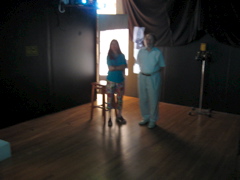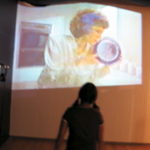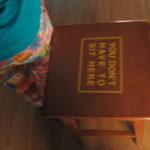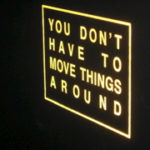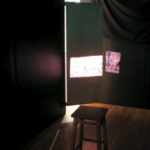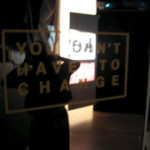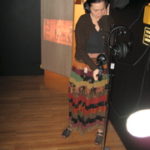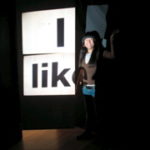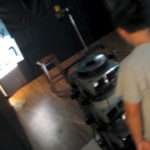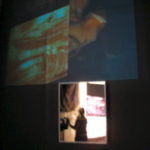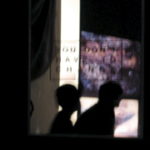Black box.
A black box theater (or experimental theater) consists of a simple, somewhat unadorned performance space, usually a large square room with black walls and a flat floor.
In this invention, an interactive space with theatrical components. There, in the corner of the exhibition hall. A slit of an entrance and tented black fabric peeking out the top.
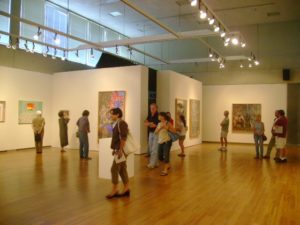
There, at the entrance:
You don’t have to read this.
Full text:
You don’t have to read this, truly. You are choosing to read it, to walk through this door, to open yourself up to possibility and to engagement with the elements within this black box installation.
There is perhaps nothing more important in life, I believe, than making conscious choices. As a maker of media messages, I am concerned that our culture provides excessive “outer directions” that have been overtaking “inner guidance.” Media messages can catch us — telling us what we need, how often we need it, and promising us happiness and fulfillment, a compelling spiritual goal of all human beings.
There are so many choice in the marketplace, and we may feel pressured to make a choice, the right choice, before we even know from our insides if it is right for us. In the face of full-pitch consumer culture, we can feel overwhelmed, over-stimulated, and become passive as a result, shutting down.
So, I invite you to enter this installation in the spirit of overcoming passivity, the inertia disease of our times. You don’t have to engage with any of the elements within this installation, but I hope you will consciously choose to.
Reviews:
Shepp is a multi-media artist who employed the exhibit theme, Unspoken Dialogues, most dynamically. She constructed a small, black-painted room in the corner of the gallery with a makeshift swinging door. “You Don’t Have to Read This,” was an entirely interactive installation containing stations with video projections, audio, a medicine cabinet with small vials, a real-time security camera, and slide projectors that viewers could use to create their own phrases. Concerned with people mindlessly obeying consumer culture, Shepp wished us to be confronted with choice. Upon entering the door, the first images seen are the projected text “By Thee” and “You Don’t Have to Change.” By the time the viewer is inside the room, a video camera has projected her image on the wall, together with the signs. At each interactive station, one is reminded that no action is required. Despite being told that I didn’t have to listen to what was on the three audio stations, I picked up the headphones to hear night insects, odd percussion sounds, and Baroque orchestral music.
–Denise Stewart-Sanabria, for the Art Journal Number
I really took to this piece, but I don’t know whether I did so in exactly the way you wanted me to. I found the entire piece to be a very clever manipulation of me as the onlooker. With every single example of something that I was told I “didn’t have” to do I felt compelled to do so, far more so than if the piece had merely issued a direct challenge or an order. I was curious throughout as to whether this was part of the intention or not. Another part of me felt bound up by limits of my choices: I could manipulate the projections that shone upon the door to create my own personal three-word phrase but only within the word choices given to me. I could choose which headphones to spend time with but again only with the limits imposed upon me; I suppose I was all the more aware of the limits placed upon me than I would be in a purely didactic piece because I had the illusion of choice. I therefore left this piece of paper note to you as an attempt to break out of those limits – to do something that nobody had suggested I do.
I saw the piece as a bit of a sly dig at the choices given to the consumer by capitalism. I’m not exactly a Marxist nor a religious person but I still find a certain spiritual emptiness in modern consumerism. What is all the more frustrating, as a friend of mine put it, is that if I want to rebel it’ll give me things to rebel with: rebel clothes, rebel music, rebel makeup most likely, and all the time “it” is living off my rebellion. I imagined wandering around town center, with all the shops saying: “You don’t have to buy this…” but with the implication that if I didn’t then my life wouldn’t be as good; I might be an outcast from society.
I don’t think I am that cynical throughout my existence, but those were my impressions of the piece. I see art as something which makes one think, and it certainly left me with that for a while and I am able to bring it back in my memory for this e-mail to you clearly.
–Guy Patching, gallery visitor
